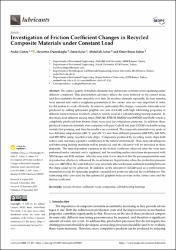| dc.contributor.author | Güneş, Aydın | |
| dc.contributor.author | Düzcükoğlu, Hayrettin | |
| dc.contributor.author | Salur, Emin | |
| dc.contributor.author | Aslan, Abdullah | |
| dc.contributor.author | Şahin, Ömer Sinan | |
| dc.date.accessioned | 2024-02-13T11:07:38Z | |
| dc.date.available | 2024-02-13T11:07:38Z | |
| dc.date.issued | 2023 | en_US |
| dc.identifier.issn | 2075-4442 | |
| dc.identifier.other | WOS:001078715500001 | |
| dc.identifier.uri | https://doi.org/10.3390/lubricants11090407 | |
| dc.identifier.uri | https://hdl.handle.net/20.500.12573/1937 | |
| dc.description.abstract | The surface quality of machine elements may deteriorate over time while operating under
different conditions. This deterioration adversely affects the wear behavior in the contact areas,
and these materials become unusable over time. In machine elements especially, the heat transfer,
wear amount and surface roughness parameters in the contact area are very important in order
for the system to work efficiently. In order to understand this change, composite materials were
produced by adding spheroidal graphite cast iron (GGG40) with high lubricating properties at
different rates to bronze (CuSn10), which is widely used as a self-lubricating bearing material. In
this study, four different mixing ratios (B60D40, B70D30, B80D20 and B90D10) and B100, which is
completely produced from bronze chips, were used for comparison purposes. In addition, these
produced composite materials were compared with pure CuSn10 and pure GGG40 via double-acting
isostatic hot pressing, and then the results were examined. The composite materials were made at
two different temperatures (400 ◦C and 450 ◦C) and three different pressures (480 MPa, 640 MPa
and 820 MPa) using recycled waste chips. Composites produced by recycling waste chips both
reduce costs and make a positive contribution to the natural environment. Thus, more advantageous
self-lubricating bearing materials will be produced, and the efficiency will be increased in these
materials. The time-dependent variation in the friction coefficient observed after the wear tests
performed under constant load is explained, and the resulting surface structures are presented with
SEM images and EDS analyses. After the wear tests, it was observed that the process parameters used
in production effectively influenced the wear behavior. In particular, when the production pressure
was low (480 MPa), the wear behavior was adversely affected because sufficient bonding between
the chips could not be achieved. In addition, as the amount of GGG40 used as a reinforcement
material increased, the spheroidal graphite contained in it positively affected the wear behavior. The
lubricating effect provided by this spheroidal graphite reduced wear in the contact area and the
friction coefficient. | en_US |
| dc.description.sponsorship | Konya Technical University OYP Projects Coordination Unit 2014-OYP-86 | en_US |
| dc.language.iso | eng | en_US |
| dc.publisher | MDPI | en_US |
| dc.relation.isversionof | 10.3390/lubricants11090407 | en_US |
| dc.rights | info:eu-repo/semantics/openAccess | en_US |
| dc.subject | recycle | en_US |
| dc.subject | friction coefficient | en_US |
| dc.subject | wear | en_US |
| dc.subject | composites | en_US |
| dc.subject | self-lubricating bearings | en_US |
| dc.title | Investigation of Friction Coefficient Changes in Recycled Composite Materials under Constant Load | en_US |
| dc.type | article | en_US |
| dc.contributor.department | AGÜ, Mühendislik Fakültesi, Makine Mühendisliği Bölümü | en_US |
| dc.contributor.authorID | 0000-0001-6930-1934 | en_US |
| dc.contributor.institutionauthor | Aydın, Güneş | |
| dc.identifier.volume | 11 | en_US |
| dc.identifier.issue | 9 | en_US |
| dc.identifier.startpage | 1 | en_US |
| dc.identifier.endpage | 13 | en_US |
| dc.relation.journal | LUBRICANTS | en_US |
| dc.relation.tubitak | 113M141 | |
| dc.relation.publicationcategory | Makale - Uluslararası Hakemli Dergi - Kurum Öğretim Elemanı | en_US |


















